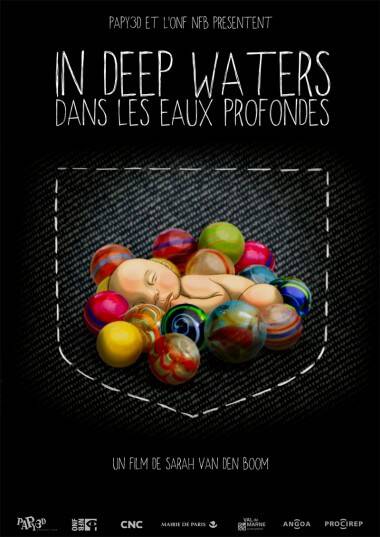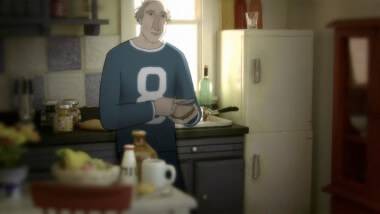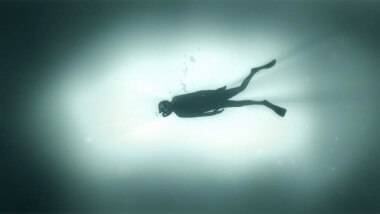Interview with Sarah Van Den Boom, director of ‘In Deep Waters’
In our latest director interview Skwigly meets Sarah Van Den Boom, an animator and illustrator based in Paris, France. Following a stint at Acme Filmworks she set up her own production company Papy3D in 2006 along with Richard Van Den Boom, bringing on board directors Gilles Cuvelier (Love Patate), Franck Dion (Edmond Was A Donkey) and Jeremy Clapin (Palmipédarium) as well as composer Pierre Caillet. As a filmmaker Sarah’s own work includes 2005’s Novecento, Pianist, 2009’s The Skeleton Woman and her most recent film In Deep Waters (2015), produced by Papy3D in association with the National Film Board of Canada. Combining photographed, physically-constructed sets with traditional 2D animation overlaid, In Deep Waters is an exploration of ‘Vanishing Twin Syndrome’; a constant sense of incompleteness that can stem from our time in the womb. The film has so far enjoyed a strong festival reception, having screened at over forty festivals including DOK Leipzig, Lille International Short Film Festival, Tricky Women and the Manchester Animation Festival. Presently screening at France’s Clermont Ferrand International Short Film Festival and Anima 2016 in Brussels with upcoming screenings at ITFS Stuttgart, Ciné-court animé in Roanne and Mecal 2016, In Deep Waters recently won the Festivals Connexion Award at Annecy 2015 amongst other accolades and is nominated for a 2016 Canadian Screen Award.
UPDATE: In Deep Waters is now available to watch online in full via Papy3D:
Prior to In Deep Waters your film The Skeleton Woman received a great deal of festival exposure. What sort of projects have you been involved with in the interim?
Oh, many things: commercials, illustrations, and I’ve worked as a character designer on a series called Pok and Mok. This experience made me want to work with photographic backgrounds and 2D characters. Of course, In Deep Waters looks completely different from Pok and Mok, it’s just two different worlds, but I liked the concept and wanted to explore it in a personal way.
As with many accomplished animation directors you’ve also produced commercial work as well as being involved in TV series and feature films. Have these experiences been beneficial when it comes to directing your personal work?
My way of working, when directing shorts, is quite particular because it relies on intuition: you have to go and find what’s being whispered at the very core of your being. You have to be listening for this fine sliver of a voice, and it’s not always easy to stay in touch with it when you have a crew to supervise and technical issues to sort out! It’s completely different from what you do in a studio as an animator, and it’s also completely different from directing a commercial spot, where things are much more playful and on the surface.
I think all types of work experience are worth taking on. They’re all challenges that necessarily mean you will evolve, that force you to define yourself as an artist. Even when an experience isn’t all that enjoyable, you still get something out of it—even if it’s simply the conviction that you never want to go in that direction again! So yes, these diverse work experiences have helped my mature as a director, but so have my reading, and my kids!
 How did you come to be intrigued by the subject matter of In Deep Waters?
How did you come to be intrigued by the subject matter of In Deep Waters?
Well, I arrived at the subject much in the same way as my main character in the film: in the course of a conversation with my mother! She told me that when she was pregnant with me, she’d had severe bleeding, and had to be hospitalized. I’ll never know for sure in my case, because they didn’t do ultrasounds back then, but the possibility that I had vanishing twin syndrome was a shock to me. I wanted to learn more: I talked to a doctor, I did research on the Web, and I found a forum where people were swapping stories about the topic. That made me want to make a film about it. I started travelling all over France, meeting people and interviewing them, and the film gradually grew out of that.
What sort of research methods went into the crafting of the film’s dialogue? Were they transcribed from real-life case studies?
Two of the three characters in my film are based on real people that I met (the girl and the secondary male character). For those two, I simply transcribed the interviews and picked the best passages, and then those lines were spoken by actors. The third character whose story drives the film is a fictional character who is kind of a patchwork of different true stories. I needed a throughline character and I found it touchy to delve too far into the life of one real person in particular. Plus I needed a bit of narrative flexibility.
What led to the decision to use 2D animation overlaid on constructed sets?
I think I simply wanted to vary the techniques in my work and not always be doing the same thing! Building sets is something I was really keen on at that point. And I wanted to anchor these characters in a more tangible environment: my interview subjects had welcomed me into their homes, in their everyday surroundings, with their possessions… I wanted to recreate something like that. I could have done a stop-motion film, but on the other hand my characters aren’t very anchored; there’s something keeping them in some other dimension. The fragility of 2D animation lent itself very well to expressing that.
You also have a primary role at Papy3D – can you describe how the studio came together and, in terms of production, what its main areas of interest are?
Papy3D is first and foremost an association of a handful of filmmakers who at a certain point wanted a bit more control over their films’ production. We’re all directors from Paris or Lille (but Lille isn’t very far from Paris). We have a very collective way of working; all decisions are voted on and the majority rules. Papy3D is kind of a six-headed hydra. It’s hard to pin down our editorial line. We all find ourselves on complex films, fairly cinematographic, quite far removed from cartoon animation. We’re starting to open up to directors from outside our structure and this question necessarily comes up. We definitely like strange films that go into some pretty deep places and shake the viewer up a bit.
You have an accomplished performance background spanning theatre, singing and dance – has this contributed in any way to the development of your animation?
I think in the beginning I was much more attracted to the live performing arts and to writing, rather than drawing. I come from a family where everyone draws, so that path was a very natural one for me and paradoxically very reassuring… But at the end of the day what I like is to tell stories, create a setting, characters, an atmosphere, and have all that lead somewhere. Animation lets me put all those skills together. I’m extremely fortunate to be around actors, musicians, designers, sound effects people, and to move from one discipline to another as I complete a production… Animation is kind of this crossroads of very diverse talents.
Having used the same composer for several projects, can you describe what it is about your respective creative processes that works so well together?
I just really love Pierre Caillet’s work. I find it has this crazy elegance, and he has a huge gift for understanding what I’m trying to say, almost better than I do. Plus, working with someone you know very well is invaluable: you work faster, more accurately; you hit the bullseye right away. Pierre generally starts thinking about the music at the same time as the script is being written. Since he’s part of Papy3D, he’s even there for the writing process. So we truly work in tandem.
The NFB seems to be a constant hub of creative activity and exciting new work. Is there anything in particular you’re witnessing from them that you find especially inspiring?
What I found really fantastic with the team at the NFB is how available each member is to serve the film. Everyone is committed to doing an impeccable job, to the goal of making the most beautiful film possible, and that quality is hard to find elsewhere on such a large scale. When you come to the end of the production process, and you’ve been carrying your film from the script stage through to animation, it’s tremendously useful to have people so good at listening and so good at their jobs, whom you can count on to take the film as far as possible. The NFB is like a wonderful, great big incubator.
In your films to date you’ve combined 2D animation, sculpture and photography amongst others. Are there any new territories you wish to explore in your future work?
Well, I happen to be writing my next film and I’ve been wondering exactly that! I really want to try stop-motion someday, but not this time, I don’t think… I’m deep into the research stage, so I can’t say just yet. Every film has a specific technique that’s right for it!
In Deep Waters is presently screening as part of Clermont Ferrand’s national competition programme as well as Anima 2016 in Brussels this Saturday (13th). For more info on the film visit papy3d.com
See more work by Sarah Van Den Boom at sarahvandenboom.fr



